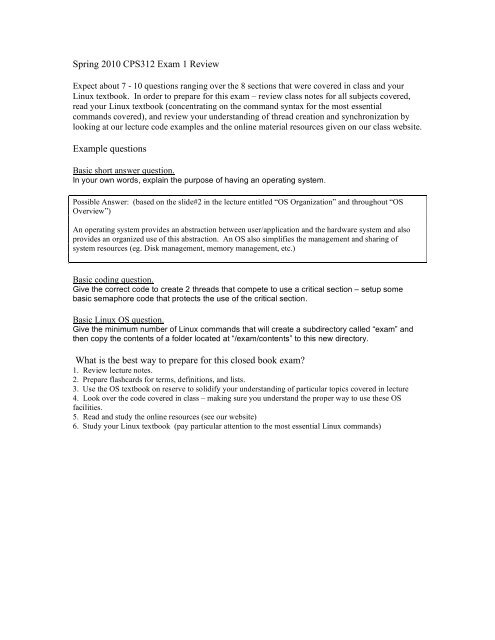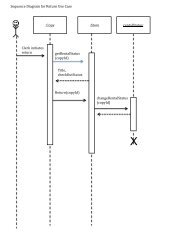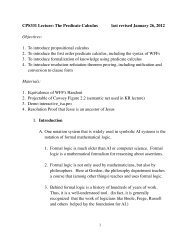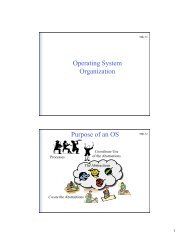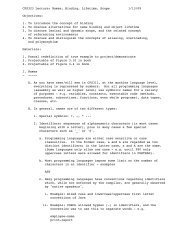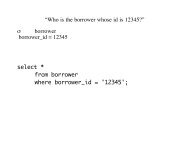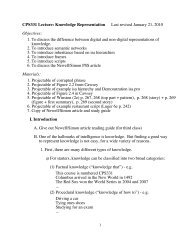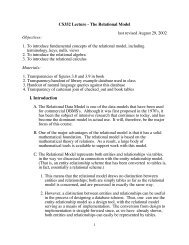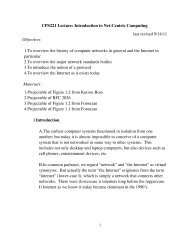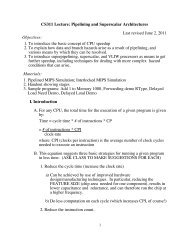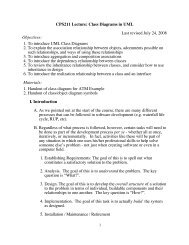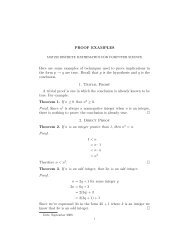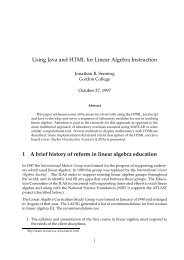Spring 2010 CPS312 Exam 1 Review Example questions What is ...
Spring 2010 CPS312 Exam 1 Review Example questions What is ...
Spring 2010 CPS312 Exam 1 Review Example questions What is ...
Create successful ePaper yourself
Turn your PDF publications into a flip-book with our unique Google optimized e-Paper software.
<strong>Spring</strong> <strong>2010</strong> <strong>CPS312</strong> <strong>Exam</strong> 1 <strong>Review</strong><br />
Expect about 7 - 10 <strong>questions</strong> ranging over the 8 sections that were covered in class and your<br />
Linux textbook. In order to prepare for th<strong>is</strong> exam – review class notes for all subjects covered,<br />
read your Linux textbook (concentrating on the command syntax for the most essential<br />
commands covered), and review your understanding of thread creation and synchronization by<br />
looking at our lecture code examples and the online material resources given on our class website.<br />
<strong>Exam</strong>ple <strong>questions</strong><br />
Basic short answer question.<br />
In your own words, explain the purpose of having an operating system.<br />
Possible Answer: (based on the slide#2 in the lecture entitled “OS Organization” and throughout “OS<br />
Overview”)<br />
An operating system provides an abstraction between user/application and the hardware system and also<br />
provides an organized use of th<strong>is</strong> abstraction. An OS also simplifies the management and sharing of<br />
system resources (eg. D<strong>is</strong>k management, memory management, etc.)<br />
Basic coding question.<br />
Give the correct code to create 2 threads that compete to use a critical section – setup some<br />
basic semaphore code that protects the use of the critical section.<br />
Basic Linux OS question.<br />
Give the minimum number of Linux commands that will create a subdirectory called “exam” and<br />
then copy the contents of a folder located at “/exam/contents” to th<strong>is</strong> new directory.<br />
<strong>What</strong> <strong>is</strong> the best way to prepare for th<strong>is</strong> closed book exam?<br />
1. <strong>Review</strong> lecture notes.<br />
2. Prepare flashcards for terms, definitions, and l<strong>is</strong>ts.<br />
3. Use the OS textbook on reserve to solidify your understanding of particular topics covered in lecture<br />
4. Look over the code covered in class – making sure you understand the proper way to use these OS<br />
facilities.<br />
5. Read and study the online resources (see our website)<br />
6. Study your Linux textbook (pay particular attention to the most essential Linux commands)
OS Overview and Usage<br />
Why study OS design?<br />
<strong>What</strong> <strong>is</strong> an Operating System? goals?<br />
OS abstraction and resource sharing<br />
Multiprogramming concepts<br />
Concept of batch programming and time-sharing<br />
Difference between a classic process and a modern process with threads<br />
Concept of context switching<br />
Code to create processes – fork, join, etc.<br />
Bootstrapping an OS<br />
Computer Organization (see notes – CPS311 review)<br />
Computer Startup<br />
Functions of Interrupts, Interrupt Handling<br />
I/O, Storage Structure<br />
Storage Hierarchy (Caching)<br />
OS Organization<br />
Overview of Process, Memory, and Storage Management<br />
OS design constraints<br />
Various other design dec<strong>is</strong>ions<br />
Processes and Threads<br />
Thread state transition<br />
Model of process execution<br />
Understand pthreads, thread pools, fork and exec, signal handling, cancellation <strong>is</strong>sues<br />
Programming with POSIX Threads (know the specifics)<br />
CPU Scheduling<br />
All topics except the specific OS examples<br />
Model of process execution<br />
Details of context switching<br />
<strong>What</strong> makes a good scheduling policy<br />
Different scheduling algorithms (understand Gantt charts and criteria for judging the algorithms)<br />
Process Synchronization<br />
Should understand bounded-buffer, producer/consumer, and readers/writers problem<br />
Aspects of synchronization – spin locks, mutex, semaphore and semaphore implementation<br />
Programming with POSIX semaphores (know the specifics)<br />
Communication<br />
Signal handling, message passing (both asynch and synch), and pipes<br />
Dining philosopher’s problem (deadlock problem), simultaneous semaphores<br />
Linux OS System (from your Linux textbook Chapters 1 - 9)<br />
Concentrate on the core Linux commands


